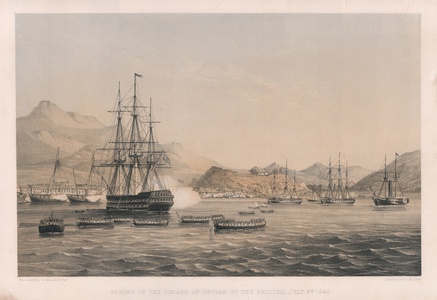| Method | Lithograph with tint stone |
| Artist | after Sir Harry Darell |
| Published | Day & Son Lithrs. to the Queen. 1852. |
| Dimensions | Image 295 x 450 mm, Sheet 354 x 518 mm |
| Notes |
A view of the taking of Chusan Island by the British on July 5th 1840, plate two from the series China, India, Cape of Good Hope and Vicinity. A Series of Thirteen Treble-Tinted Views published by Day and Son, London, 1852. The scene shows the British naval forces in the foreground, a large ship to the left surrounded by smaller row boats filled with men. Plumes of smoke can be seen emanating from the ships as the troops prepare to land. On the land a large number of Chinese troops can be seen occupying the hill and shore, defending against the British. The Capture of Chusan by the British forces in China occurred on 5th and 6th of July 1840, during the First Opium War. On 21 June 1840, sixteen British ships of war, four armed steamers and twenty-eight transporters carrying approximately 4000 soldiers had assembled off the coast of Macao. A small force was left behind to blockade Canton while the rest left immediately for their target. On 5 July, the British fleet appeared off Chusan and bombarded the island before landing and capturing it from the Chinese forces. Sir Harry Francis Colville Darell Bt (1814 - 1853) was a British Lieutenant-Colonel and an amateur artist. Darell joined the army in 1832 and became Captain in 1841. He served in the 18th Royal Irish in the Anglo-Chinese War (First Opium War) and was present for the Capture of Chusan. for his participation in this war he received the China War Medal. He was appointed Major in the 7th Dragoon Guards in 1847 and Lieutenant Commander in 1848 where he fought in the Seventh Xhosa War in South Africa from 1846-1848. Darell was an amateur artist, depicting scenes he saw during his service, most notably his paintings of India and South Africa. He died of a fever in 1853, with the Baronetcy going to his brother, Rev. William Lionel Darell. The firm of Day & Haghe was one of the most prominent lithographic companies of the nineteenth-century. They were also amongst the foremost pioneers in the evolution of chromolithography. The firm was established in 1823 by William Day, but did not trade under the moniker of Day & Haghe until the arrival of Louis Haghe in 1831. In 1838, Day & Haghe were appointed as Lithographers to the Queen. However, and perhaps owing to the fact that there was never a formal partnership between the two, Haghe left the firm in the 1850's to devote himself to watercolour painting. The firm continued as Day & Son under the guidance of William Day the younger (1823 - 1906) but, as a result of a scandal involving Lajos Kossuth, was forced into liquidation in 1867. Vincent Brookes bought the company in the same year, and would produce the caricatures for Gibson Bowles' Vanity Fair magazine, as well as the illustrations for Cassells's Poultry Book, amongst other commissions. Condition: Some staining to margins. Repaired tears to right and upper margin. Some minor chips to sheet edges. |
| Framing | unmounted |
| Price | £500.00 |
| Stock ID | 52985 |

